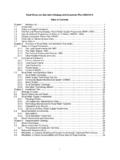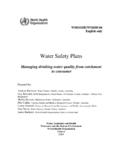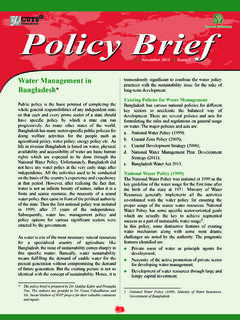Transcription of 14 - WHO
1 2001 World Health Organization (WHO). Water Quality: Guidelines, Standards and Health. Edited byLorna Fewtrell and Jamie Bartram. Published by IWA Publishing, London, UK. ISBN: 1 900222 28 014 Risk communicationSue Lang, Lorna Fewtrell and Jamie BartramThere is an increasing number of factors affecting water supplies for whichresponsible agencies should have a risk communication programme in factors might include chemical as well as microbiological hazards. Inaddition, there is a growing realisation that for risk communication to beeffective it should be a continual and evolving process and not simply a crisismanagement chapter considers some elements of effective risk communication thatare applicable to the fields of recreational water and wastewater reuse as well asdrinking water (from which most examples are drawn).
2 RISK COMMUNICATIONRisk communication is any purposeful exchange of information about risksbetween interested parties. More specifically in the context of this book, riskcommunication is the act of conveying or transmitting information betweenparties about a range of areas including:318 Water Quality: Guidelines, Standards and Health levels of health or environmental risks the significance or meaning of health or environmental risks decisions, actions or policies aimed at managing or controllinghealth or environmental parties include government, agencies, corporations and industrygroups, unions, the media, scientists, professional organisations, interestedgroups, and individual citizens (Covello et al.)
3 1991).All too often it has been the case, with regard to policy making, that therewas an emphasis on public misperceptions with a tendency to treat alldeviations from expert estimates as products of ignorance or stupidity (Bennett1999), hardly an ideal basis for meaningful communication! Fortunately thisstance is gradually changing, to acknowledge that public reactions to risk oftenhave a rationality of their own, and that expert and lay perspectives shouldinform each other as part of a two-way process (Bennett 1999).
4 The necessity of the two-way process has been highlighted by the FAO/WHO:Ongoing reciprocal communication among all interested parties is an integral part of therisk management process. Risk communication is more than the dissemination ofinformation, and a major function is the process by which information and opinionessential to effective risk management is incorporated into the decision. (Bennett andCalman 1999)The days when it was possible to take a we know best approach, simplyinforming the public that a risk has been identified, telling people not to worry,and stating what was intended to do about it, have in most cases long gone(Coles 1999).
5 The public today no longer automatically acquiesce to authorityand now demand a greater role in decision-making (McKechnie and Davies1999). This, while opening up a route for better decision-making andstakeholder involvement, is no small undertaking and involves some majorchallenges (McCallum and Anderson 1991), including: Provision of information when science is uncertain. Explanation of the risk assessment process. Incorporation of the differing ways that various groups interpret thescience into risk communication strategies.
6 Accounting for differing concepts of an acceptable level of risk. Provision of information that assists in personal decisions andinforms opinions on policy. In terms of incident management, maximising appropriate publicresponses and minimising inappropriate public communication319It is no accident that risk management, which was traditionally depicted as alinear process, is now generally viewed as a cyclic process with riskcommunication at its heart (Figure ).Figure The risk management cycle (adapted from Chorus and Bartram 1999).
7 Responsible water management agencies should adopt a risk managementphilosophy through which the relevant agency is able to preserve its shareholdervalue, reputation and credibility, and market share (if appropriate) in the eventof a health or environmental risk. An essential component of this philosophy isa risk audit process, which will assist to identify likely issues requiring riskcommunication strategies, with the central circle of Figure being made upof numerous different are a number of functions that a risk communication programme mightseek to fulfil (Renn and Levine 1991) including:320 Water Quality: Guidelines, Standards and Health Enlightenment role (aiming to improve risk understanding amongtarget groups).
8 Right-to-know (designed to disclose information about hazards tothose who may be exposed). Attitude modification role (to legitimise risk-related decisions, toimprove the acceptance of a specific risk source, or to challengesuch decisions and reject specific risk sources). Legitimate function (to explain and justify risk managementroutines with a view to enhancing the trust in the competence andfairness of the management process). Risk reduction role (to enhance public protection throughinformation about individual risk reduction measures).
9 Behavioural change role (to encourage protective behaviour orsupportive actions towards the communicating agency). Emergency readiness role (to provide guidelines or behaviouraladvice for emergency situations). Public involvement role (aiming at educating decision-makersabout public concerns and perceptions). Participation role (to assist in reconciling conflicts about risk-related controversies).Clearly, given these different possibilities it is important to have a definedobjective (what is the aim of the risk communication?)
10 Before proceeding. Asnoted by Corvello (1998), however, the overall goal of risk communicationshould not be to diffuse public concerns but should be to produce an informedpublic that is involved, interested, reasonable, thoughtful, solution-orientatedand key consideration of risk communication is that the target will rarely be asingle audience, but usually a variety of audiences, and as such messages mustbe tailored to consider the different audiences that are likely to have differentinterests, values, levels of intelligence, education and understanding.













